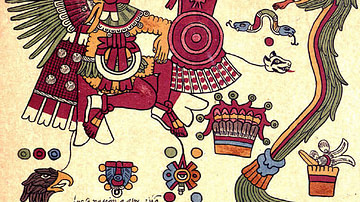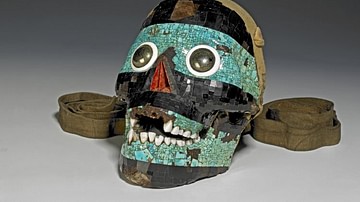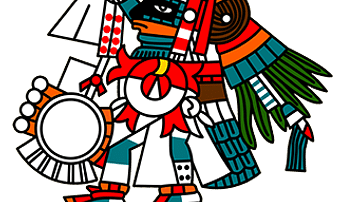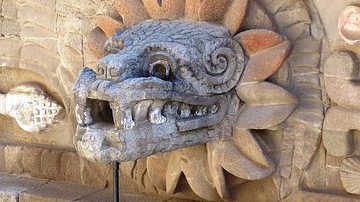The Tizoc Stone is a huge stone cylinder from the Aztec capital of Tenochtitlan which depicts a sun-disk on its flat upper surface and carries a frieze around its outer edge showing Aztec warriors and the Aztec king Tizoc, whose reign from 1481 to 1486 CE was troubled by rebellions across the empire. The stone was almost certainly used during sacrificial ceremonies in either fighting contests or as a receptacle for the hearts of sacrificial victims.
The huge stone is made from basalt and measures 2.67 m in diameter and stands 92.5 cm high. Covered in rich relief carvings the stone as a whole is thought to represent the cosmos as defined by the Aztec Empire. The top surface shows a sun-disk with eight points or rays representing the four cardinal and inter-cardinal directions. Running around the upper edge of the outer surface of the stone is a band of stars representing the heavens whilst running around the lower edge is a double row of pointed vertical blades which represent the earth. This lower band also has four masks depicting the Aztec earth deity, each placed at one of the four cardinal points.
The main frieze which runs around the outer edge of the stone is carved in relief and depicts 14 Aztec warriors taking captive the gods of other conquered civilizations. The warriors, all facing to the right and, therefore, moving counter-clockwise around the stone, are grasping the gods by their hair which was a standard way to represent capture and submission in Aztec art. Also depicted, wearing the full ceremonial regalia of the gods Huitzilopochtli and Tezcatlipoca which includes a large headdress, is Tizoc himself. The various cities that the captives represent are shown via name glyphs and the stone, therefore, represents the Aztec domination of central Mexico, glorifying, in their eyes, the order that their Empire brought to the cosmos.
The stone may have been used as a platform in the fighting contests which were a common ritual in Aztec sacrifices. In these bouts a single victim was made to fight against a squad of hand-picked warriors or knights. Naturally, the victim had no possibility to survive this ordeal or even inflict any injury on his opponents as not only was he tied to the circular stone platform (temalacatl) but his weapon was usually a feathered club while his opponents had vicious razor-sharp obsidian swords or clubs (macuauhuitl). An alternative function of the stone may have been as a cuauhxicalli or receptacle to receive the hearts of sacrificial sacrifices.
The Tizoc Stone was discovered on the 17th of December 1790 CE under the Plaza de la Constitución of Mexico City, which was constructed over the Aztec capital of Tenochtitlán. It now resides in the National Museum of Anthropology in Mexico City.






